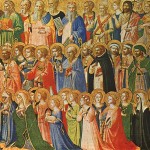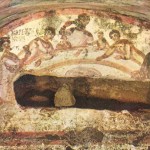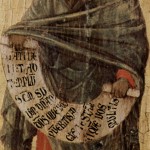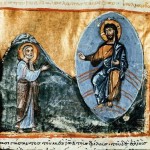
Jeremiah 1:4-10 and/or Isaiah 58:9b-14
What It’s About: Isaiah and Jeremiah are two of the greatest and most important prophets in the Hebrew Bible, and these passages serve as short synopses or thesis statements for the two books. They do so in different ways, though.
The Jeremiah text is from the very beginning of the book–probably, actually, the “original” beginning (if we can really speak of an original in a text like this), since verses 1-3 were probably a later editorial addition. This is Jeremiah’s call story, where God–or at least the “word of the Lord”–came to Jeremiah and set him aside for a prophetic career. As a call narrative, these verses have a lot to say about Jeremiah’s work and words, and the way God intends them to be heard. God wants Jeremiah’s words to reach a wide audience, and to “pluck up and pull down, to destroy and to overturn, to build and to plant.” This seems pretty accurate for the role of a prophet and for Jeremiah in particular, who preached destruction and judgment but also hope and new birth.
The Isaiah text, in contrast, comes from near the end of that book, in what scholars call Third Isaiah. It is also a kind of a synopsis, and it’s a sort of mission statement for God’s people moving forward. It describes a program for rehabilitating society, and for correcting many of the ills that led to destruction and death in the first place. Isaiah calls for charity, justice, and grace in social dealings, and in exchange for that, God promises “the heritage of your ancestor Jacob.”
What It’s Really About: It’s always dangerous to conflate a bunch of books and read them as a whole without paying attention to their particularities and their different agendas. But read as a unit, the prophets are remarkably consistent about a few things. They condemn religious promiscuity, and advocate faithfulness to God. They condemn greed and selfishness, and advocate justice in society. And they promise destruction and trauma, but also promise hope in a future that is coming. These two passages cover all of those bases, and so they are nice synopses of the prophetic books together.
What It’s Not About: It’s not about competency or training. Often, people feel the need to justify their lives with call stories–how they got to be the way they are. These are often tales of conversion, how a person turned from their wayward lives toward God. Or in the case of ministers, it’s often a story of how a person felt God’s called, and recognized the gifts they had. This passage from Jeremiah, in fact, is often cited in ordination papers as an analogue to what people feel about their own lives. But significantly, in Jeremiah, it is God’s words and not Jeremiah’s that make a difference. Jeremiah himself has few skills or competencies to bring to the table; he is “only a boy.” We talk a lot about being “gifted and called” for ministry of various sorts, but sometimes, in the bible, the called people don’t turn out to be all that gifted. They’re just called.
Maybe You Should Think About: If you’re one of those congregations that wrings its hands about “mainline decline” and worries about its own continuing existence, the Isaiah passage might have a lot to say. The whole thing is constructed in if/then statements, and it’s aimed squarely at people who are standing in ruins wondering what happens next. If that describes you or your congregation, there is a lot in this passage to be hopeful about. Look at verse 12. That’ll preach.
What It’s About: What a beautiful and strange text. The language of Hebrews can be evocative and moving, and that’s what we see here. As I said in last week’s blog on Hebrews, I am one of those who thinks that Hebrews was a sermon given in the city of Rome, and this kind of language really seems to me to suggest that context. It reads like a sermon exhorting those who come from a Jewish background–whether Jews proper or the “God-Fearer” gentiles who sometimes associated with synagogues–to continue a faithful journey with Christianity. It references Jewish history and Jewish texts, while casting that history and those texts in a salvation history that culminates in Christian faith. It’s easy for me to imagine this message making sense as a part of a sermon.
What It’s Really About: There is a textual note in verse 18 that seems to be important. The first line, which reads “You have not come to something that can be touched,” appears in some ancient manuscripts as “You have not come to a mountain that can be touched.” That second reading, with the “mountain,” makes more sense in context. (Most likely, a later scribe added “mountain” to clarify the text, and the “something” is the earlier reading, which is why the NRSV puts that in the text and “mountain” in the notes). That “mountain” helps to make sense of the text, though; Hebrews is commenting on the experience of Moses atop Mt. Sinai, and using that to think about the ways we encounter God. There is a message here about the accessibility of God on the one hand and the utter transcendence of God on the other.
What It’s Not About: People who, like me, were evangelicals in the 1990s will read verse 29 and immediately think of this.
Maybe You Should Think About: Hebrews represents the thinking of an early Christian as he (or she) attempts to make Christianity intelligible to people who have been steeped in Jewish thought and history. Hebrews takes reference points from the past (Abel, Moses, Sinai, sacrifice) and uses them to reinterpret the past. It does so in a way that also honors that past; it doesn’t reject it, but makes a new interpretation of it. This seems to me to be a marked improvement over what many Christians do today, which is reject Judaism altogether, or reject it mildly as an irrelevant predecessor to Christianity. Hebrews is contending with Judaism as a tradition, and while it does some violence to that tradition (by appropriating it), I think we could learn better habits from reading history this way, rather than the way European Protestantism has led us to read it, which is as outdated, useless, faithless history. Hebrews sees Judaism as a part of a faithful past, present, and future; maybe we should work harder to see it that way too.
What It’s About: This passage checks two boxes on the Jesus list: a healing/exorcism story, and a story of conflict with religious leaders. Here, a woman who has been hunched for 18 years because of a “spirit” is healed of her affliction, leading to one of the “sabbath controversies” of Luke. (For similar confrontations see 4:14-30, 4:31-38, 4:44, 6:1-5, 6:6-11, and 14:1-6). This angers the leader of the synagogue, because he’s the one in charge of enforcing sabbath observance, and Jesus has just violated the rules. Jesus’ response is that sure, he violated the rules, but so does everyone else, and anyway, he did it for a good reason.
What It’s Really About: These stories of conflict with religious leaders are usually read by Christians to show the synagogue leaders as rigid, legalistic, and heartless while Jesus is flexible and compassionate. They’re very effective when read that way, but reading them that way ignores a lot of context that is important. The major thing to know is that Jesus and the synagogue leader in this story (and others like it) are engaging in a very common form of Jewish disputation; they are arguing over the correct interpretation and enactment of the law. Neither of them is advocating for the law to be rejected or abolished; they are fighting about how to interpret it. And it’s easy to see this story as a high-stakes drama over the meaning of an entire religious tradition, but Jews did this all the time (and so do lots of other kind of people). There is a very, very rich tradition of argument and disputation in Judaism, and this fits very well into that tradition. The line at the end of this passage, in verse 17, is Luke’s own commentary and almost certainly does not reflect Jesus’ own understanding of what had happened in the dispute. Jesus would have thought of this as one Jew debating another Jew about the limits of sabbath restrictions. Christians misread it when they make it more than that.
What It’s Not About: It’s pretty amazing how much the exorcism aspect of this is downplayed. This becomes a story about “work” on the Sabbath, but the way it is told, the woman’s ailment is because of a “spirit.” Jesus heals her, presumably, by neutralizing that spirit. (In verse 16 we learn that it is Satan who has “bound” her, so this is no ordinary spirit). It seems like another line of argumentation available to Jesus would have been that exorcism doesn’t count as “work,” but instead he argues that healing her was analogous to untying a donkey.
Maybe You Should Think About: What’s at stake in these stories of conflict with religious leaders? Why does Luke tell and emphasize these stories? Is it to draw distinctions between Jesus and Judaism? Or is it to underscore how Jesus is an active participant in the intellectual life of Judaism? And in either case, what can we read into Jesus’ presence in a synagogue, teaching and healing and arguing? Seems like at the very least we can say that Jesus wasn’t rejecting his faith. Jesus was showing up to synagogue.












